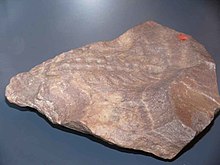|
Xenusion
Xenusion auerswaldae is an early lobopodian known from three[1] specimens found in glacial erratics on the Baltic coast of Germany.[2] Another specimen, discovered shortly after the holotype, was briefly observed but soon went missing. Except for this lost specimen, the fossils probably originated in the Kalmarsund Sandstone of Southern Sweden,[3] which was deposited in the Lower Cambrian (Upper Tommotian–Lower Atdabanian; Stages 2→3).[4] It is the oldest currently known lobopodian with soft body fossils.[5] The specimens are not especially well preserved. The older specimen is 10 cm or so in length with a narrow, weakly segmented body. Assuming it was the posterior section, the specimen was estimated to be part of an animal about 20 cm in length.[2] A depression runs up the bottom on all but the rearmost segments. There is a slightly bulbous termination, and each segment before that seems to have a single pair of tapering annulated legs similar to the modern onychophoran, but without specialized feet and claws. More than 10 body segments were present.[6] There is presumably a spine on each body bump and faint transverse parallel striations on the annulations on the legs.[2][6] The legs of what is possibly the foremost segments are either absent or not preserved. The head is believed to be missing or poorly preserved. Based on a new specimen that shows the anterior section, it possibly had a long narrow proboscis,[2] but this also suggested to be a preservational artefact.[7] Xenusion has been reinterpreted as an Ediacaran frond animal by Tarlo, and a drawing of that interpretation has been presented by McMenamin.[8] In a photograph presented in The Treatise on Invertebrate Paleontology Volume O, the organism's appearance seems to support the original interpretation more. Further studies of Xenusiid close the possibility of a Rangeomorphy affinity.[2][6] References
External links |
||||||||||||||||||||||||||||||||||

